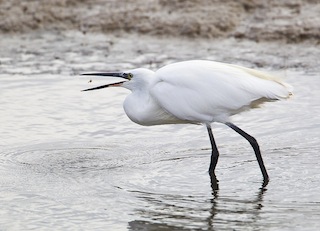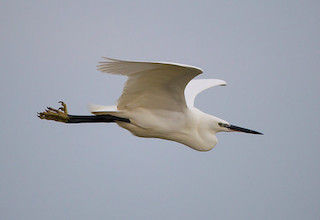 The bright yellow feet of the Little Egret make it look as though they’ve been dipped in paint.
The bright yellow feet of the Little Egret make it look as though they’ve been dipped in paint.
Photo: © Natural England/Allan Drewitt
Scientific name: Egretta garzetta
Conservation status: IUCN Red List, Least Concern; UK Birds of Conservation Concern, Amber
What to look for:
- Family: Ardeidae (Bitterns and Herons)
- Colouring and appearance: White plumage, heron-like, white crest on head, black legs, black beak and bright yellow feet.
- Size: 60 cm length, 92 cm wingspan.
- Where: Estuaries on the south and east coasts of England and Wales.
- Call: Mainly silent, but some croaking in breeding season, and has a harsh alarm call.
- Similar species: Great White Egret (which is much larger and has black feet), Grey Heron (also much larger, and with grey plumage).
 Little Egrets still seem somewhat exotic for our British shores. They have been colonising the UK along the south coast since the late 1980s, and bred here (in Dorset) in 1996. This is not the first time the Little Egret has been seen here, though. Historical records show that it was found in Britain up to the late mediaeval period but became extinct, probably due to hunting and changing climatic conditions. Their recent recolonisation is the result of a natural expansion of their range across France, and the estuaries of Devon and Cornwall are good places to look out for them. Some 700 pairs now breed in the UK, and overwintering numbers are as high as 4,500
Little Egrets still seem somewhat exotic for our British shores. They have been colonising the UK along the south coast since the late 1980s, and bred here (in Dorset) in 1996. This is not the first time the Little Egret has been seen here, though. Historical records show that it was found in Britain up to the late mediaeval period but became extinct, probably due to hunting and changing climatic conditions. Their recent recolonisation is the result of a natural expansion of their range across France, and the estuaries of Devon and Cornwall are good places to look out for them. Some 700 pairs now breed in the UK, and overwintering numbers are as high as 4,500
These beautiful, heron-like birds are very easy to spot in our estuaries and inland waters, with their striking white plumage and yellow feet. They are often found in the shallow water as they hunt for their meals of fish and crustaceans, but are less statue-like than their heron cousins, preferring to walk slowly along, or even run with raised wings to disturb their prey. Although a solitary feeder, Little Egrets nest and roost in groups, with colonial nesting sites sometimes containing several hundred birds. Nests are usually built in trees or shrubs close to water.
The Amber status of the Little Egret in the UK is because of the small breeding population.
 Did you know…?
Did you know…?
…The Little Egret’s neck plumes (seen when in breeding plumage) were once much sought after, and were worth more than gold. They were used from the seventeenth to nineteenth centuries for decorating hats.
…Little Egrets were on the menu for the banquet celebrating the crowning of King Henry VI in 1429.
More information and references:
Svensson, L., Mullarney, K., Zetterstrom, D.,1986. Collins Bird Guide, second edition (translated by Christie, D., Svensson, L.). HarperCollins, London.
Published: January 2015
Author: Amanda Scott
Photos: © Natural England/Allan Drewitt
